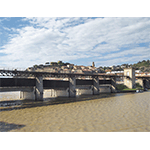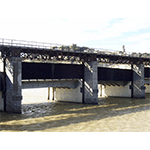Giorgini Bridge
The 1827 construction of the bridge on the Bruna River, on a project by engineer Gaetano Giorgini, was the first act of the great hydraulic reclamation ordered by Grand Duke Leopold II and aimed at reclaiming Maremma. Inaugurated in 1828, the purpose of the bridge was to avoid the fresh-water of the Bruna River from mixing with the salt water of the sea. This effect was indeed considered one of the principal causes of malaria. The bridge was sited at the lowest point of the river, so as to channel all of the lake water, but far enough away from the sea so as to avoid the waves pushing strongly against the floodgates, and also to be able to use the river as a port-channel. It was formed by two side trusses, three round arches and two pillars; the arches were made of brick, while the rest of the structure was in masonry lined with marble slabs. The bridge was 26 metres long, 12 metres wide and 9 metres high. It was equipped with three suspended floodgates, each one equipped with two doors formed by an iron frame lined with oak wood. The doors swung on iron pivots and were closed manually or automatically by the force of the high-tide current, preventing the sea water from entering the swamp; they were instead opened during low tide by the force of the lake water that thus emptied into the sea. It was the task of a military picket to guard the bridge, attend to the maintenance of the doors, and log the times of their opening and closing.
The grand-ducal bridge today supports the modern bridge built in 1930 by the Maremma Reclamation Consortium.
****************************
Texts by Graziano Magrini
English translation by Victor Beard
Last update 25/feb/2008





